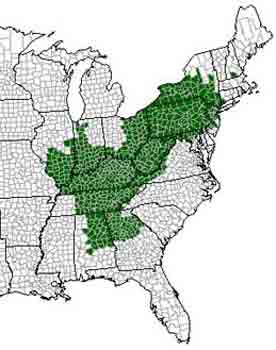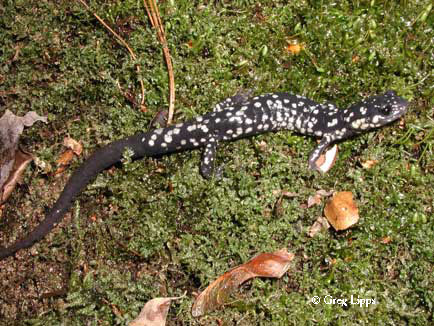
Northern Slimy Salamander
(Plethodon glutinosus glutinosus)
 |
 |
|
|
Distribution of the Northern Slimy Salamander (from the AR MI Atlas)
|
An adult Northern Slimy Salamander. Note the lack of white spots on this individuals regenerated tail.
|
|
Description: A large (up to 9”), black colored salamander with numerous silvery white flecks on the body, tail, and head. The underside is black, but slightly lighter than the dorsum. The white sticky secretions that this species emits from its glands (especially along the tail) when disturbed further helps to identify the Slimy Salamander. |
||
Distribution in Ohio: Reported from the eastern and southern portions of the state. |
||
|
|
||
Status in Ohio: May be locally abundant. |
||
|
|
||
Habitat: Forested hillsides and talus slopes where it lives under logs, rocks, and other debris. It is sometimes found in the crevices of rock outcrops or in the twilight zone of caves. |
||
|
|
||
Life history: Reproduction occurs in the summer, with eggs being attached to the roof of an underground cavity or rock crevice. The larval stage is completed within the egg, and hatching occurs 2-3 months after the eggs are deposited. Newly hatched Slimy Salamanders apparently do not emerge from their hidden retreats until the following spring. Sexual maturity is reached in 3-5 years. |
||
|
|
||
Conservation: Slimy Salamanders are tied to forest habitats. Destruction of these habitats is the greatest threat to populations. Logging of forests causes an increase in temperature and the rate of evaporation and possibly also impacts the salamander’s food source. Like all lungless salamanders, pollutants, including herbicides and pesticides, are easily absorbed through their porous skin and are toxic to the Slimy Salamander. |
||
Last modified:
|
Ohio Amphibians · Ohio Salamander Web · Ohio Salamander Species · Amphibian Habitats · Salamander Monitoring |
|